The very nature of art museums and galleries is being transformed into immersive, three-dimensional environments, thanks to state-of-the-art technology. This has led to expansive, under-used urban sites replacing the traditional “white cube” gallery.
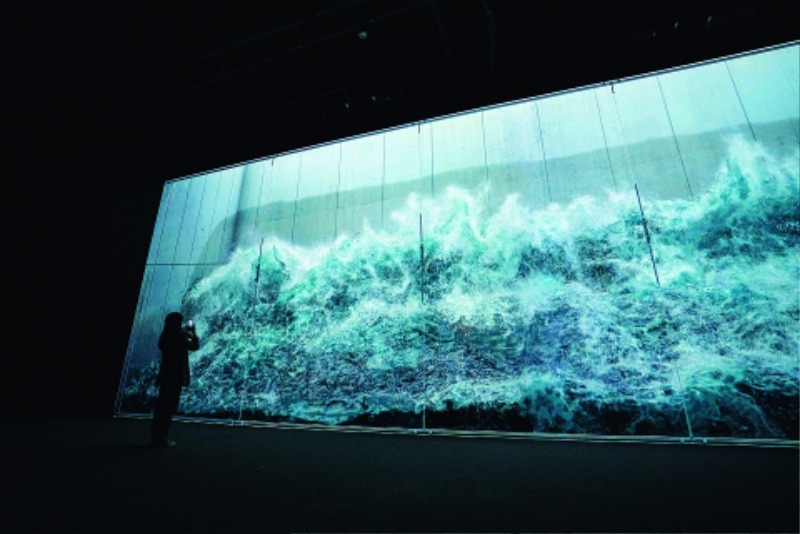
“Wave” is a media art piece on show at ARTE MUSEUM Yeosu. It uses anamorphic techniques to pump up the optical illusion of three dimensions. Opened in August 2021, this museum has 12 works on display, all on the ocean theme, in keeping with the coastal city character of Yeosu.
ⓒ d’strict
In late 2014, the “Van Gogh: A Record of 10 Years” exhibition literally introduced another dimension in displaying art by exploring the renowned painter’s oeuvre with video art. The resulting three-dimensional presentation leaped ahead of two-dimensional paintings. It delivered realism: people in Van Gogh’s paintings moved, cypress trees shook in the wind, and his house seemed tangible. Audiences could hardly contain their delight. The exhibition at the War Memorial of Korea in Yongsan, Seoul, proved so popular that it was extended for another month.
Cutting-edge motion graphics and projection-mapping technologies gave viewers a strong sense of immersion. Motion graphics involve computer software that s moving images. Projection mapping is a technology that beams images onto a surface, be it a building wall or a simple . Also used in concerts and musicals, this is the same technology that captured the attention of audiences worldwide during the opening ceremony of the PyeongChang 2018 Winter Olympics.
A New Mode
The increasingly popular genre of immersive media art is indebted to advances in digital technology. Multiple projectors are used to cast images on blanket walls, columns, and the floor of exhibition spaces. Until recently, appreciating a work of art typically involved taking a few steps back to absorb its entirety. But with immersive media art using an entire space as the canvas, exhibition visitors can experience the illusion of entering the work itself and becoming a part of it.
The new genre coincides with the desire of younger viewers to be participants, not merely passive onlookers. Thus, the popularity of media art installations is rising, prompting changes not only in the way art is enjoyed, but also to the spaces in which art is experienced. More and more art galleries are exhibiting works of immersive media art creators, and dedicating more space for permanent installations.
These new immersive media art spaces are the vanguard to mainstreaming experiences at highbrow art galleries. The first example was a hidden Jeju Island bunker that Korea Telecom had used to manage the undersea optical cable system of Korea’s telecommunications network.
TMONET, a mobile payment solution company, converted the former Korea Telecom facility and opened it in November 2018 as Bunker des Lumières, an AMIEX (Art & Music Immersive Experience) exhibition for French art.
AMIEX involves technology that adds sound to projection mapping to showcase exhibition images. More than 100 video projectors are used to beam images onto walls, ceilings, and floors, while dozens of speakers play majestic music, creating an immersive environment. With the underground, soundproof Bunker des Lumières blocking external light and sound, visitors can focus even more deeply on sound and images alike. The opening exhibition was a survey of works by Gustav Klimt.
This past May, TMONET also renovated the spacious underground theater at the Grand Walkerhill Seoul hotel, operating it as an immersive art exhibition space called Théâtre des Lumières. The new venue aligns its content production with its over 20-meter high ceiling. The emphasis on verticality contrasts sharply with the horizontal stress of the 3,000-square meter Bunker des Lumières.
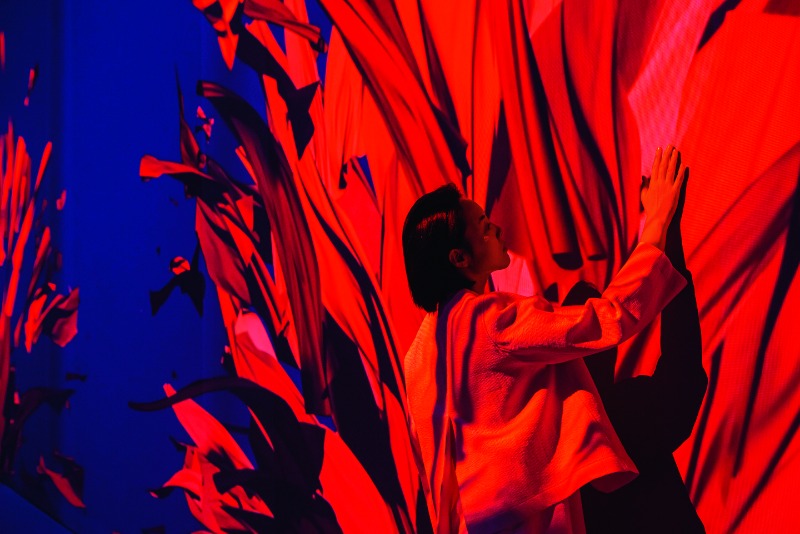
“Blue Room,” shown from June 2021 through February 2022 at dedicated media art exhibition space GROUNDSEESAW Myeongdong. Produced by media art studio HABITANT, it used dreamy, mysterious blues and powerful reds toan audiovisual experience.
ⓒ MEDIA&ART
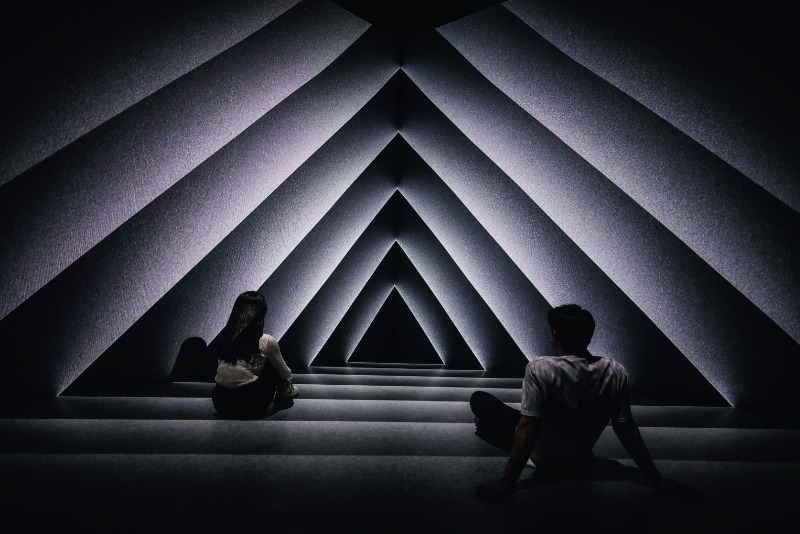
A big favorite with visitors, “Wormhole,” at the Jeju and Yeosu locations of ARTE MUSEUM, offers an immersive experience of traveling through outer space.
ⓒ d’strict
Newcomers
The success of Bunker des Lumières has led to other permanent immersive art spaces on Jeju Island. Launched in September 2020 by digital media design company “d’strict,” ARTE MUSEUM has a slightly different immersive charm. Built by remodeling a speaker manufacturing plant, this space with a floor area of some 4,600 square meters and a maximum ceiling height of 10 meters, is so far the largest venue of its kind in the country. Eleven media art exhibitions on the theme of “islands” are presented here.
The following August, d’strict opened its second permanent exhibition space – this one ocean-themed – at the Yeosu World Expo in South Jeolla Province, and followed in December 2021 with a third space near Gyeongpo Lake in Gangneung, Gangwon Province. At the latter, visitors can experience an exhibition that reflects the topographical characteristics of Gangwon and Gangneung, considered the backbone of the Baekdu mountain range. Where the Bunker des Lumières is an immersive space centered on fine art and artists, ARTE MUSEUM highlights nature, which makes it easily accessible for everyone.
ARTE MUSEUM’s exhibitions have also added smart sensors to their projection-mapping technology, in order to follow visitors’ movements and have the art respond accordingly. This motion-tracking technology (as well as wind, scent, and lighting setups) connects with the images in play to reproduce real experiences as closely as possible and maximize the impact of the space. This provides a rich experience that obscures distinctions between the real and virtual. That, in turn, is why these exhibition halls are becoming hotspots.
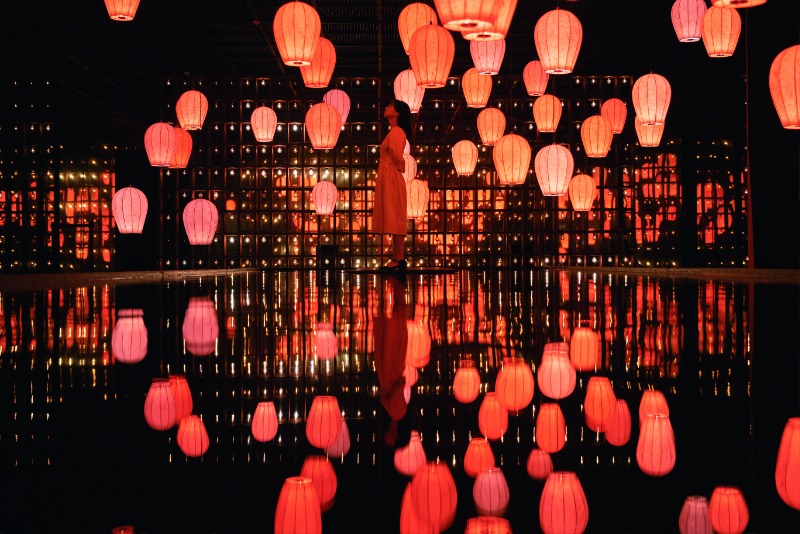
A kinetic media art exhibition that combines “Breezing Ember” and “Mysterious Fire,” two signature works by interactive media art studio SILO Lab. Lanterns flicker to the music and incandescent bulbs embedded in the walls react to visitors as they move. Since its 2019 debut, the exhibition has traveled around Korea.
ⓒ SILO Lab
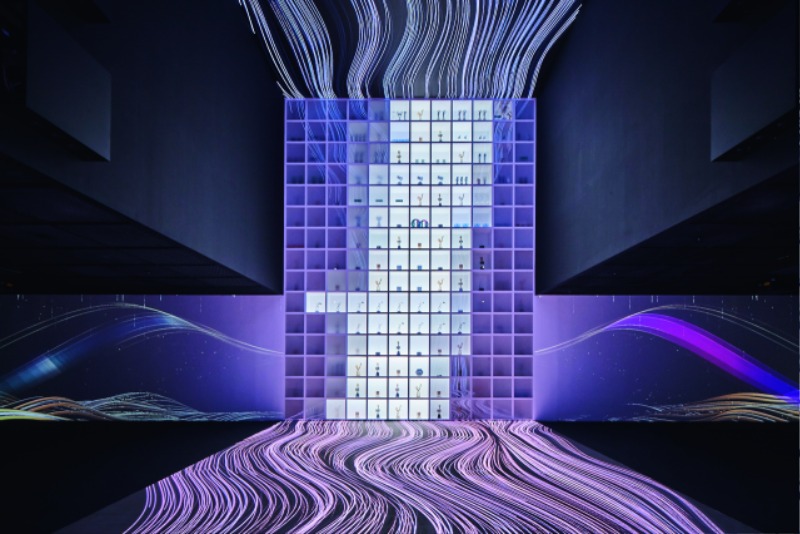
Located in Seoul’s Yongsan district, HYBE INSIGHT is a multi-use complex operated by entertainment and lifestyle platform company HYBE. Pictured here is a giant trophy wall featuring the trophies won by HYBE’s artists as well as videos.
ⓒ HYBE
Expansion in Seoul
People first started taking notice of d’strict in December 2009 because of a projection-mapping project on the external walls of Seoul National University’s Cultural Center, conducted with the school’s Information and Culture Technology Studies department. This collaborative project between industry and academia can be seen as Korea’s initial introduction to projection mapping. Using beam projectors to cast videos on 3D scans of the walls, this project effectively conveyed the message that if sea levels continue to rise due to climate change, cities will eventually be submerged.
The project that really imprinted the d’strict name on the public conscious, however, was the 2020 installation of a huge ocean wave on the outer wall of SMTOWN Coex Artium in Samseong-dong, Seoul. Called Public Media Art “WAVE,” this media façade bestowed a truly powerful visual experience on passersby. Indeed, this project was a prime example of expanding the art museum into the streets. Building on this wealth of experience, d’strict formed a media artist unit called “a’strict.” Its introductory exhibition, “Starry Beach,” at the Kukje Gallery in Sogyeok-dong, Seoul, opened in August 2020. With this grand-scale multimedia installation, a’strict established itself as a creative force to watch.
Meanwhile, MEDIA & ART, the producers behind the aforementioned “Van Gogh: A Record of 10 Years” exhibition, opened a series of multi-use cultural spaces called GROUNDSEESAW and began operating its Myeong-dong site as a media art space beginning in April 2021.
Another key entry in this lineup would be MUSEUM1, run by art content agency KUNST1. Located in Busan’s Centum City, MUSEUM1’s launch this past March marked the rebranding and reopening of a media-specialized contemporary art museum originally founded by KUNST1 in 2019. Covering around 2,300 square meters across multiple levels, this venue has been outfitted with some 80 million LEDs in the floors, ceilings and walls, all set to guide visitors to a surreal experience. Recently, the work of local Korean creators who showcase immersive media art has also been attracting sizeable attention. Often exhibiting their works in cafés, pop-up stores, flagship stores, and the like, these creators are truly transporting art galleries to public spaces.
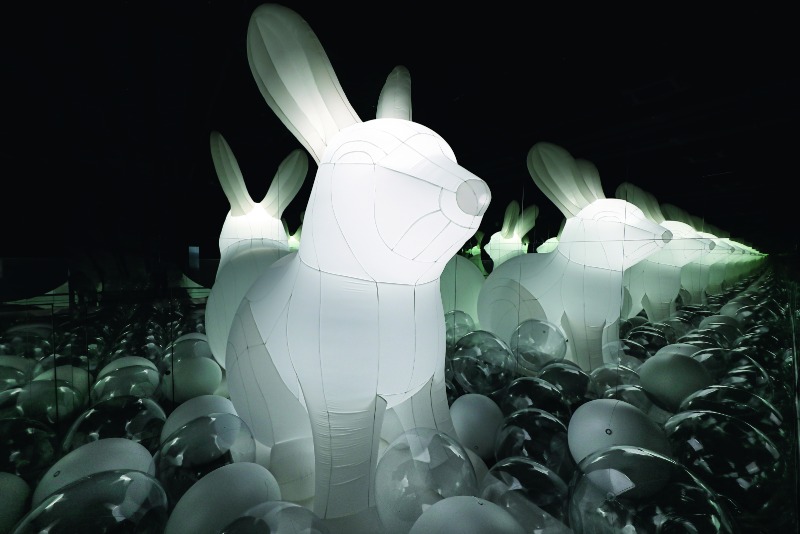
“Moon,” a media art exhibition and popular photo zone, is showing at ARTE MUSEUM in Jeju and Yeosu. One novel visual diversion comes in the form of a four-meter tall model rabbit, expanding endlessly through a mirror.
ⓒ d’strict
Heo Dae-chan Editor in Chief, Media Art & Culture Channel “AliceOn”